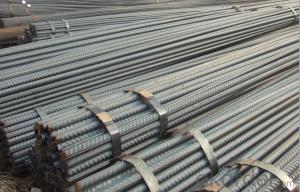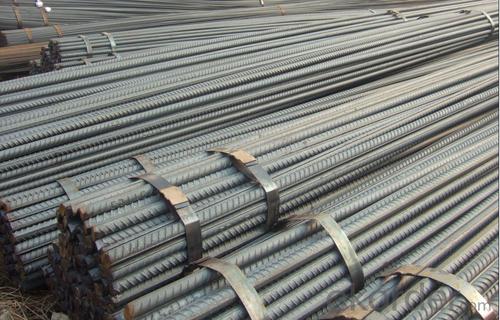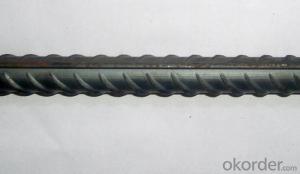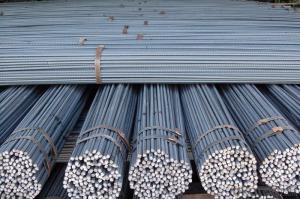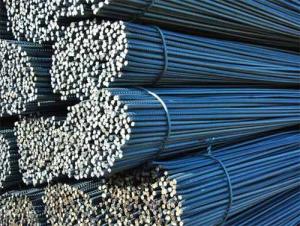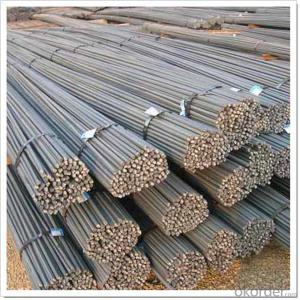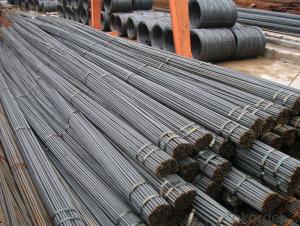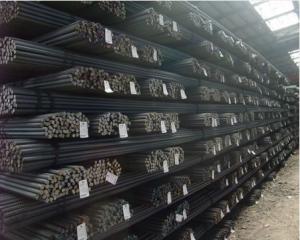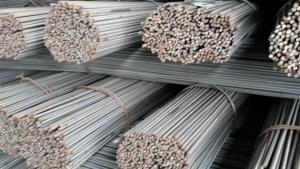Hot Rolled Carbon Steel Rebar 12mm with High Quality
- Loading Port:
- China Main Port
- Payment Terms:
- TT or LC
- Min Order Qty:
- 25 m.t.
- Supply Capability:
- 10000 m.t./month
OKorder Service Pledge
OKorder Financial Service
You Might Also Like
Product Description:
OKorder is offering Hot Rolled Carbon Steel Rebar 12mm with High Quality at great prices with worldwide shipping. Our supplier is a world-class manufacturer of steel, with our products utilized the world over. OKorder annually supplies products to European, North American and Asian markets. We provide quotations within 24 hours of receiving an inquiry and guarantee competitive prices.
Product Applications:
Hot Rolled Carbon Steel Rebar 12mm with High Quality is widely used in buildings, bridges, roads and other engineering construction. Big to highways, railways, bridges, culverts, tunnels, public facilities such as flood control, dam, small to housing construction, beam, column, wall and the foundation of the plate, deformed bar is an integral structure material. With the development of world economy and the vigorous development of infrastructure construction, real estate, the demand for deformed bar will be larger and larger..
Product Advantages:
OKorder's Hot Rolled Carbon Steel Rebar 12mm with High Quality are durable, strong.packed and suitable for construction
Main Product Features:
· Premium quality
· Prompt delivery & seaworthy packing (30 days after receiving deposit)
· Can be recycled and reused
· Mill test certification
· Professional Service
· Competitive pricing
Product Specifications:
Manufacture: Hot rolled
Grade: HRB335 HRB400 BS4449 Grade460 ASTM Grade40 Grade60
Certificates: ISO, SGS, BV, CIQ
Length:6m 8m 9m 12m
Packaging: Export packing, packed by coil
FAQ:
Q1: Why buy Materials & Equipment from OKorder.com?
A1: All products offered byOKorder.com are carefully selected from China's most reliable manufacturing enterprises. Through its ISO certifications, OKorder.com adheres to the highest standards and a commitment to supply chain safety and customer satisfaction.
Q2: How do we guarantee the quality of our products?
A2: We have established an advanced quality management system which conducts strict quality tests at every step, from raw materials to the final product. At the same time, we provide extensive follow-up service assurances as required.
Q3: How soon can we receive the product after purchase?
A3: Within three days of placing an order, we will begin production. The specific shipping date is dependent upon international and government factors, but is typically 7 to 10 workdays.
Q4: Can you supply the Rebar according to the standard KS?
A4: Yes, we can supply SD400 and SD500
Q5: How to avoid the rust after deliver the goods to the loading port?
A5: We will keep the goods at the port covered with water-proof material
Q6: What is the chemical composition and physical properties of HRB400?
A6:
Grade | Technical data of the original chemical composition (%) | ||||||
C | Mn | Si | S | P | V | ||
HRB400 | ≤0.25 | ≤1.60 | ≤0.80 | ≤0.045 | ≤0.045 | 0.04-0.12 | |
Physical capability | |||||||
Yield Strength (N/cm²) | Tensile Strength (N/cm²) | Elongation (%) | |||||
≥400 | ≥570 | ≥14 | |||||
Images:
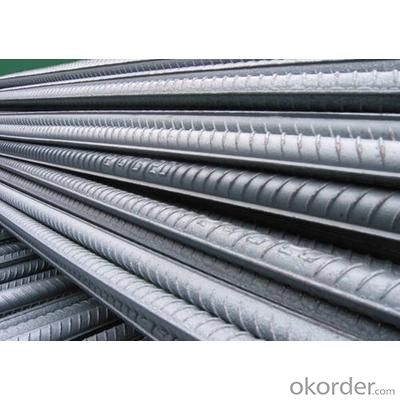
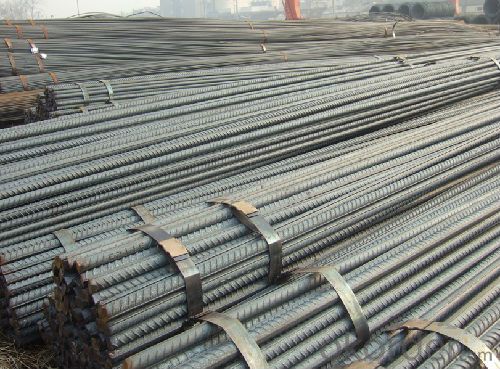
- Q: Thread steel 20*9 one is 2.001T. How many pieces of this one?
- The weight of the thread steel = diameter * diameter *0.00617=20*20*0.00617=22KG, and then the total quality of this piece in the weight of a single thread steel, you can clearly get the number of roots.
- Q: What are the guidelines for the proper spacing of steel rebars in slabs-on-grade?
- The guidelines for the proper spacing of steel rebars in slabs-on-grade are crucial to ensure the structural integrity and longevity of the concrete slab. Here are the general guidelines that should be followed: 1. Concrete cover: The first consideration is the concrete cover, which refers to the distance between the surface of the rebar and the edge of the concrete. The minimum cover requirements are typically specified by local building codes or engineering standards and should be adhered to strictly. This cover protects the rebar from corrosion and provides sufficient fire resistance. 2. Spacing between rebars: The spacing between the rebars is determined by the load requirements and the dimensions of the slab. The closer the spacing, the stronger the slab will be. However, it is important to maintain a proper spacing to allow for the concrete to flow freely around the rebar during pouring and ensure proper consolidation. As a general rule, the spacing should not exceed three times the thickness of the slab or 18 inches, whichever is smaller. 3. Bar size and diameter: The size and diameter of the rebars used in the slab will depend on the load requirements and design specifications. Typically, the larger the load, the larger the diameter and the spacing between the rebars will be. Common rebar sizes for slabs-on-grade range from #3 (3/8 inch diameter) to #8 (1 inch diameter). 4. Reinforcement placement: The placement and positioning of the rebars within the slab is also critical. The rebars should be positioned in the center of the slab's thickness to ensure proper load distribution. Additionally, they should be securely tied or supported to prevent displacement during concrete placement and consolidation. 5. Joint reinforcement: In slabs-on-grade, construction joints are often included to accommodate expansion and contraction. Proper reinforcement of these joints is essential to maintain the structural integrity. Joint reinforcement, such as dowel bars or tie bars, should be placed perpendicular to the joint and adequately anchored to both sides of the joint. It is important to note that these guidelines serve as a general overview, and specific project requirements may vary. Consulting with a structural engineer or following local building codes and industry standards is essential to ensure compliance and optimize the design of steel rebars in slabs-on-grade.
- Q: Are steel rebars prone to bending or warping?
- Yes, steel rebars are prone to bending or warping under certain conditions. The flexibility and malleability of steel make it susceptible to bending or warping when subjected to excessive stress, temperature changes, or improper handling during construction or transportation. Proper reinforcement techniques and quality control measures can help minimize the risk of bending or warping in steel rebars.
- Q: What are the factors that determine the strength of steel rebars?
- Several factors contribute to the strength of steel rebars. Firstly, the composition of the steel used in their manufacture plays a crucial role. The presence of elements like carbon, manganese, and silicon significantly impacts the steel's strength by enhancing its ability to resist tension and provide structural stability. Secondly, the manufacturing process of rebars influences their strength. Quenching and tempering, a process involving rapid cooling after heating, is typically employed to achieve the desired strength. The precise temperature and duration of this process affect the grain structure and chemical properties of the steel, thereby impacting the rebars' strength. The size and shape of rebars also affect their strength. The diameter and length of a rebar determine its load-bearing capacity. Thicker and longer rebars generally possess higher strength as they can withstand greater stress and distribute it more effectively. Furthermore, the presence of impurities or defects in the steel can weaken rebars. Cracks, voids, or inclusions compromise the structural integrity of the rebar and reduce its strength. Finally, environmental conditions must be considered when determining the strength of rebars. Factors like temperature, humidity, and exposure to corrosive substances can impact their strength over time. Taking precautions, such as using corrosion-resistant coatings or stainless steel rebars, is essential to ensure the longevity and strength of rebars in such environments. In conclusion, the strength of steel rebars depends on the composition of the steel, the manufacturing process, the size and shape of the rebars, the presence of defects, and the environmental conditions in which they will be used. Considering these factors is crucial to ensure the durability and reliability of steel rebars in construction applications.
- Q: Can steel rebars be used in both residential and commercial construction?
- Yes, steel rebars can be used in both residential and commercial construction. They are commonly used to reinforce concrete structures such as foundations, columns, beams, and slabs in both types of construction projects.
- Q: How do steel rebars contribute to the overall aesthetics of a building?
- Steel rebars do not directly contribute to the overall aesthetics of a building as they are typically hidden within the concrete structure. However, their presence is crucial for providing structural integrity and strength, ensuring the building's safety and durability.
- Q: What is the process of threading steel rebars?
- The process of threading steel rebars involves using a specialized machine to cut threads onto the ends of the rebars, which allows them to be easily connected together. This threading process enhances the structural integrity, stability, and overall strength of the rebars when used in construction projects.
- Q: What are the advantages of using corrosion-resistant steel rebars?
- The advantages of using corrosion-resistant steel rebars are that they provide increased durability, longer lifespan, reduced maintenance costs, and enhanced structural integrity in reinforced concrete structures.
- Q: How are steel rebars protected against accidental damage during construction?
- Steel rebars are protected against accidental damage during construction through a variety of measures. One common method is to place plastic caps on the ends of the rebars to prevent them from getting damaged or bent. Additionally, rebars can be covered with plastic or foam sleeves to provide an added layer of protection. Construction workers are also trained to handle rebars carefully and avoid any activities that may cause accidental damage.
- Q: Can steel rebars be used in the construction of office buildings?
- Yes, steel rebars can be used in the construction of office buildings. Steel rebars are commonly used as reinforcement in concrete structures, including office buildings, to provide strength and stability. They are crucial in reinforcing the concrete and enhancing the building's overall structural integrity.
Send your message to us
Hot Rolled Carbon Steel Rebar 12mm with High Quality
- Loading Port:
- China Main Port
- Payment Terms:
- TT or LC
- Min Order Qty:
- 25 m.t.
- Supply Capability:
- 10000 m.t./month
OKorder Service Pledge
OKorder Financial Service
Similar products
Hot products
Hot Searches
Related keywords
